The Crash
The following photographs, looking west, were taken on 19 June 1944. The aircraft crashed into the house, just east of the station, and tore off the roof. Refugees from Le Havre were living there, but nobody inside was killed. Behind to the left is the station, and to the right the brickworks. The village is a kilometre or so further to the west.
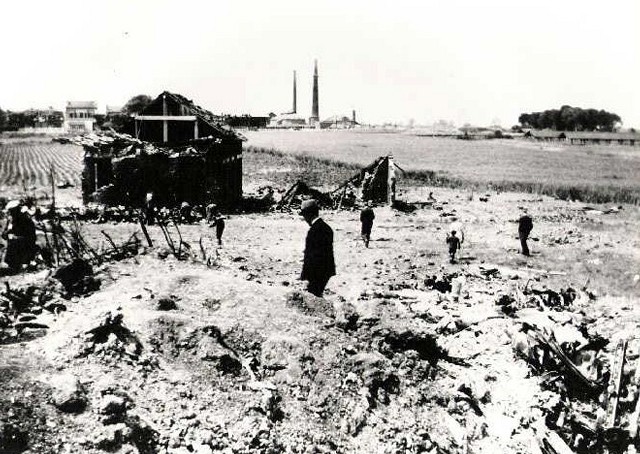
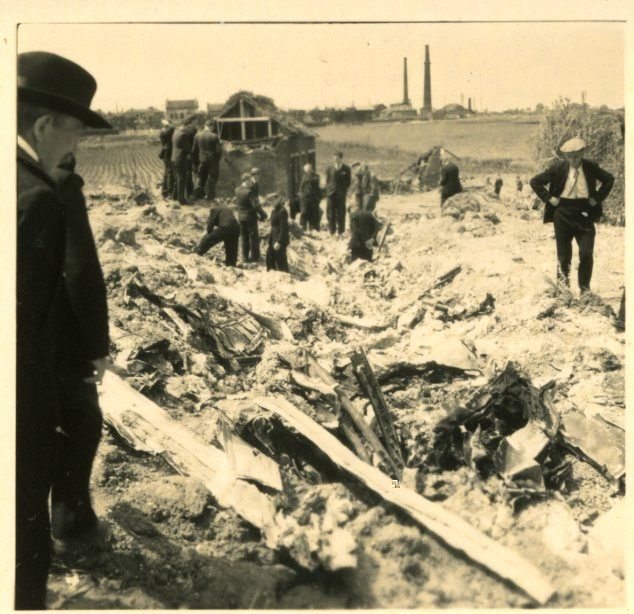
The next photograph was taken in 2007, looking north. The railway can be seen to the left, with the now unstaffed and hardly used station just off the edge of the picture. The house which was damaged is the one with a red roof just left of centre, the others nearby are postwar. The crash was in the field across the lane, a bit to the east, though now there is no sign of this, from the air or on the ground.
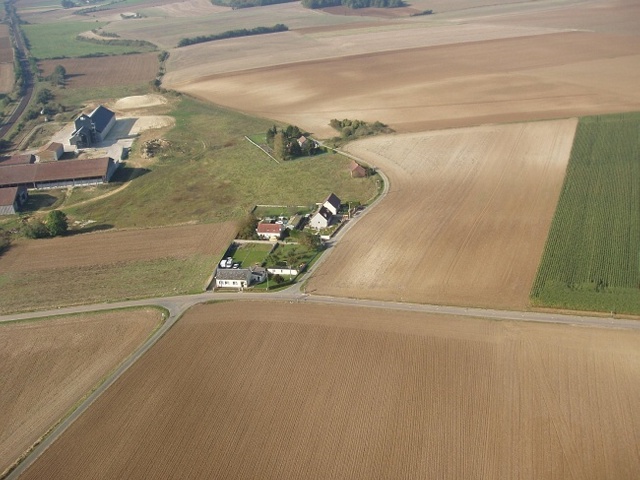
A memorial stone was unveiled at the 65th anniversary ceremony. This stands at the near end of the lane past the crash site, in view of those passing along the D164 road running across the picture between Gannes and Sains-Morainvillers.
More than 60 years later, small fragments of the Lancaster still turn up. This shows several mounted on a commemorative board:
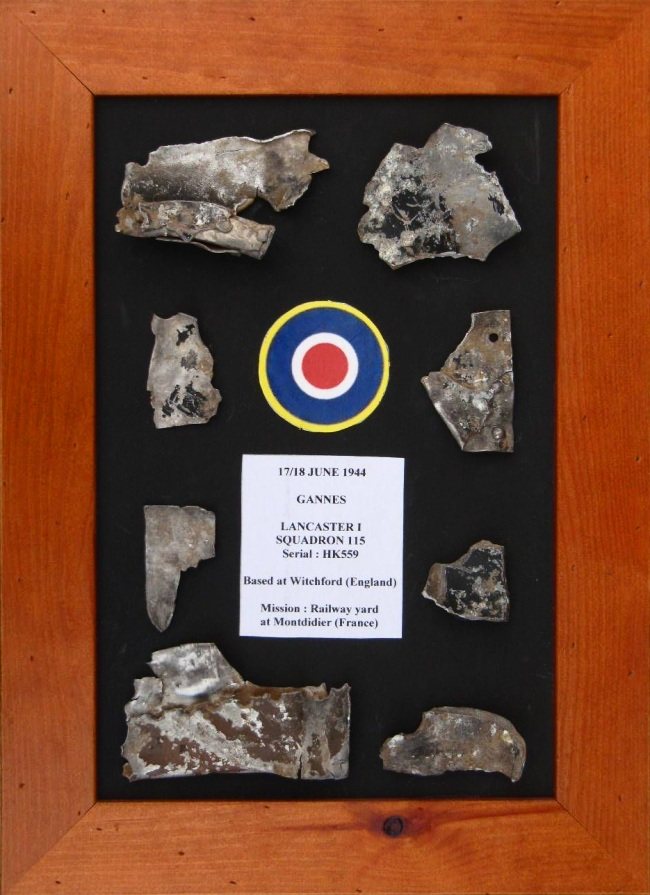
The remains of one of the engines were excavated in September 2010. The following photographs show a pair of cylinder valves as found, and one of them cleaned up to serve as the handle of a paperweight.
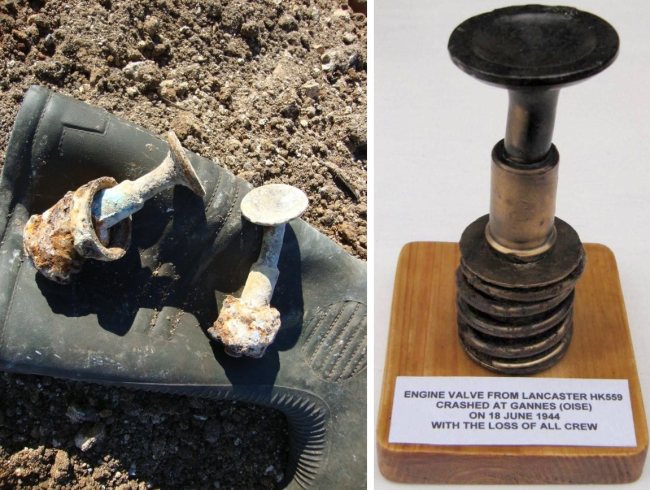
With part of the aircraft buried and the rest unidentifiable fragments, and the remains of the crew having no means of identification, it took a long time for the non-return of HK559 to Witchford and the funeral at Gannes to be associated. Thus, first the crew’s families were told that they were missing, then after some months without news that they were presumed killed in action, then eventually that they had died and been buried at Gannes.
Many letters were written by and to the families. Two, involving Alan and Katharine Traill, the pilot’s parents, are shown below, one partly and one in full.
On 25 January 1946, Alan Traill wrote to the Casualty Section of the Department of Air in Melbourne, asking about John’s death. The relevant part of the reply of 15 February 1946 was in these terms:
In reply to your request for full details concerning the circumstances of your son’s death, it is advised that the casualty was investigated by two organisations and their reports have been received in this Department.
The report received through the Directorate of Graves Registration and Enquiry states that:-
“On the 18 June 1944 a four-engined British plane crashed at GANNES (Oise). It was in flames before crashing and exploded. Plane and crew were torn to pieces and could not be identified or counted. All remains were put in two coffins and buried in one grave by the French in the Communal Cemetery of Gannes (Oise)”.
The report received from the Missing Research and Enquiry Service, Paris, states that the officer investigating the tragedy proceeded to Gannes and the Station Master took him to the scene of the crash. The officer states:-
“This aircraft appears to have gone in almost vertically and at a great speed as all four engines are deeply buried in the ground. The Station Master states the engines made a terrific noise as the machine was diving, followed by a loud explosion. The larger part of the wreckage was cleared by the Germans, the remaining pieces are scattered over a wide area.”
It seems that John Traill’s mother formed the idea that he had been burned to death, and eventually she wrote to M. Feuilloy, the Gannes stationmaster, with her concern. This is the text of his reply:
Hattencourt
20th October 1948
Madame K.M. Traill
Burwood
Dear Madame Traill,
Received your letter of the 28th September, translated in French by Mr. Brial.
Your friend, Mrs. Estell, will be welcomed by my daughter, as you yourself were at Gannes. By corresponding with my daughter [… illegible …] visit.
In case of need , I am again giving you hereunder my daughter’s address:-
Mr. & Mme. Houdant S.N.C.F. Gannes (Oise)
With reference to the question you have asked me, there has been obviously some wrong interpretation of the account given to you by my daughter. An explosion took place, in effect six hours after your son’s plane crashed but it was the explosion of a bomb which did not occur immediately after the fall of the plane. The explosion took place afterwards, the bomb having ignited by the heat of the burning plane. You may relieve your mind about the fear of your son having been trapped alive in the plane. As I could not give you many details of the occurrence during the brief time I saw you at Gannes, I will now give you the exact description as I saw it.
On the 18th June, 1944, at about two o’clock in the morning bombers were continually passing over the station (at Gannes). The weather was bleak and a strong wind was blowing. Feeling anxious about the fate of the aviators in such bad weather or upset by some presentiment, I got out of bed and looked in the dark through the window of my bedroom. I was at the window for a little while when fearing some catastrophe I was appalled by the deafening noise of the engines of a plane gradually getting nearer. During these few seconds I could not see anything in the sky until the plane exploded as it crashed at a distance of about one hundred yards in front of me. I can therefore testify as the only eyewitness of this unfortunate disaster that the plane was not in flames before it crashed on the ground as stated by the Aviation report, but that the plane exploded as it hit the ground, throwing out all its occupants off the burning plane. I immediately went to the site of the catastrophe where I was alone and to my dismay I could only ascertain that all the occupants of the plane were dead.
There, Madame, is a brief but sincere account of that drama which was all over in a few seconds but which has so cruelly struck you. As for myself I will always see this horrible vision with all the sorrow that I then shared.
May these few lines, as cruel as they are yet for you, appease somehow your immense grief and that the fear that you entertained about your son being burned alive in the plane will be dispelled off your mind for ever. I pray you to believe, Madame, to the assurance of my devoted sentiments.
Signed G. FEUILLOY
It is apparent that M. Feuilloy was at pains to allay Mrs Traill’s concern about the nature of her son’s death. At this stage it is not possible to be certain whether or not the aircraft was in flames during its descent, but nor is it clear why he claimed so confidently to be the only eyewitness if what he said was not true. Certainly, four years after the crash, he would have known long since if there had been any other witnesses with a different opinion, who could therefore contradict him in statements to further family representatives, like Katharine Traill's friend Mrs Estell referred to in the letter, whose visit presumably was expected soon. And given that she would certainly be seeing him, he would have to be prepared to maintain the fiction face to face, if that is what it was.
There are further points of interest in the two letters. In the one to Alan Traill, the statement “This aircraft appears to have gone in almost vertically” can be queried – a glance at the 2007 aerial photograph shows that a fairly shallow dive would have been required for HK559 to take the roof off the house and then to crash where it did to the east. In M.Feuilloy’s letter, his estimate of the distance from the station to the crash site is considerable below the true figure of about 250 yards, and his explanation of the explosion several hours after the crash having been due to the heat of the fire may have been mistaken, as it was common to use delayed-action bombs.
Returning to the doubt about whether or not HK559 was in flames before crashing, this is an extract of a letter of 1952 to his family from Bill Smith, Ian’s brother, about his recent visit to Gannes:
He [the stationmaster – it was not said if this was still M. Feuilloy] took me to a pub where a girl could speak a little English so after a while I had quite a crowd telling me the whole story of the crash, two of them had actually seen it. The story I got was that the plane was on fire when it passed over Gannes, it made a circle and came in fairly flatly narrowly missing the station and a shed and burst into flames when it hit the ground from the petrol and burnt out the fields all around … six or seven hours later there was a great explosion from the bomb load. From the description it appears that they were trying to make a crash landing.
Does the reference to the flatness of the dive, matching what can be deduced from the 2007 photograph, give credence to the statement about the aircraft being on fire before crashing? Did M. Feuilloy’s wish to give comfort cause him to say that which he knew to be untrue? Certainly, no definitive answers to these questions can be got now.